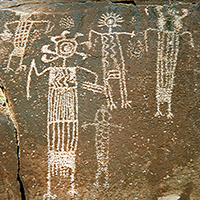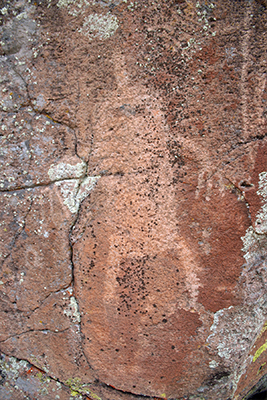Anthropomorphs
The best-defined styles are distinctive styles of anthropomorphs and bighorn sheep, and mostly developed during the Late Archaic. These “representational” styles, with the exception of the Coso and Pahranagat Anthropomorph Styles, are typically associated with Fremont and Western Puebloan cultures (ca. 2,000-750 years ago) in southeastern Nevada (including Lincoln County), Utah, and the Colorado Plateau. These semi-horticultural groups made rock art that included stylized anthropomorphs that share common attributes of trapezoidal, rectangular, or triangular body shapes. These were often portrayed with bodily decoration such as headgear, jewelry, or decorated clothing.
Anthropomorphs with similar attributes were also made by Archaic hunter-gatherers in southeastern Nevada and the Cosos (eastern California). The Pahranagat anthropomorph style is broadly contemporaneous with Fremont and Western Puebloan rock art styles, though its origins lie in the Middle Archaic. The age of Coso style rock art is poorly defined, but appears to be concentrated in the Middle Archaic. A general evolutionary sequence is apparent that stylized anthropomorphs seem to be a later development, with the exception of the Coso style.
Rock art found in Sevier Fremont territory (western Utah but extending into eastern Nevada and fairly well-represented in Lincoln County) is the most schematic or stylized of these anthropomorph styles. It comprises triangular and trapezoidal anthropomorphs, usually lacking legs, sometimes with arms, and often with headgear and ear decoration, made as pictographs or petroglyphs. At their most schematic, these are trapezoid outlines that closely resemble the shape of Fremont clay figurines.
To the south and bordering Lincoln County, Western Puebloan groups made distinctive rock art (West Virgin Kayenta style) in western Utah, the Valley of Fire and lower Moapa Valley, Nevada. These Western Puebloan rock art anthropomorphs have triangular, rectangular, or hour-glass shaped bodies, sometimes with “horns” or headgear. Most of these formal attributes are characteristic of Fremont anthropomorph styles though their visual appearance is somewhat different. This suggests that cultural practices and knowledge distinctive to Fremont or Western Puebloan peoples did occasionally cross cultural boundaries. Alternatively, the anthropomorphic traditions of both cultures may represent variations on shared cultural practices that symbolized social status through public presentation of self and manifested in rock art.
Both cultures were experiencing far-reaching economic, social, and settlement changes—i.e., the development of horticulture, reduced mobility, and resulting increases in population, more permanent villages, perhaps greater social stratification, and sporadic social conflict. The stylized anthropomorphs of these cultures may have represented new social positions and statuses that arose from economic and settlement changes, as well as being used in social practices aimed at gaining acceptance of these changes by managing social tensions by presenting them through the legitimating lens of symbolic culture.
Although the age and cultural affiliation of Lincoln County’s distinctive Pahranagat Anthropomorph Style is somewhat unclear, based on the age of associated archaeological materials, it appears to be Middle and Late Archaic in age. This age range fits with the general pattern of distinctive anthropomorph styles largely being a Late Archaic development

















